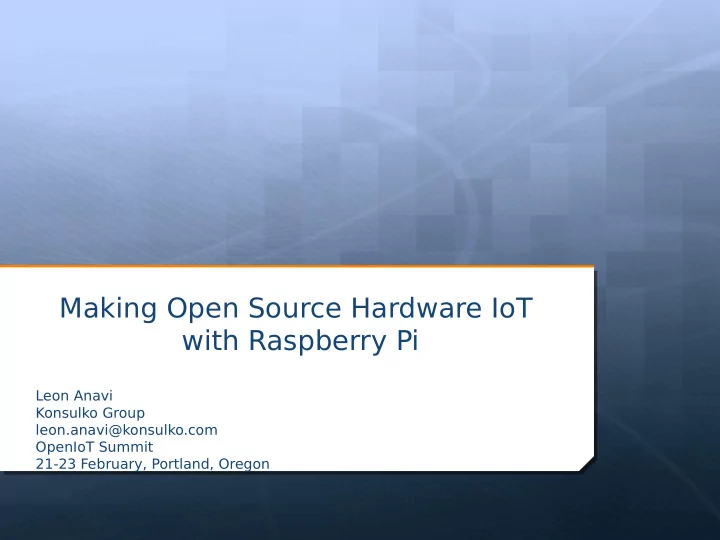

Making Open Source Hardware IoT with Raspberry Pi Leon Anavi Konsulko Group leon.anavi@konsulko.com OpenIoT Summit 21-23 February, Portland, Oregon
Agenda Raspberry Pi add-on boards for IoT Raspberry Pi HAT Raspberry Pi pHAT Designing an open source hardware Software support
What is Open Source Hardware? Design of physical objects that is publicly available so that anyone can study, modify, distribute, make, and sell the design or hardware based on that design
Open Source Hardware Licenses GNU General Public License (GPL) Creative Commons Attribution-ShareAlike CERN Open Hardware License (OHL) TAPR Open Hardware License (OHL) FreeBSD MIT Other
Why Raspberry Pi? Low cost credit-card-sized computer Good software support Huge community NOT open source hardware!
Raspberry Pi 2009 - Raspberry Pi Foundation 2012 – The 1 st Raspberry Pi 2014 – Raspberry Pi B+ 2016 – Raspberry Pi Zero
Raspberry Pi Flavors
Many add-on boards
Important Change in B+ 40 pins 26 pins Raspberry Pi B Raspberry Pi B+ (2014) (2011)
Raspberry Pi Flavors
40 Pin Header
Raspberry Pi HAT Since 31 st July 2014
Raspberry Pi HAT != HAT Hat op) (Hardware Attached on T
HAT Requirements Form factor and dimensions (65x56mm) 40 pin header compatible with Raspberry Pi B+ and the newer models EEPROM with device tree fragment Details: https://www.raspberrypi.org/blog/introducing-raspberry-pi-hats/ https://github.com/raspberrypi/hats
pHAT Form factor suitable for Raspberry Pi Zero with 4 mount holes and dimensions 65x30mm 40 pin through-hole header EEPROM not mandatory * Not an offjcial standard of the Raspberry Pi Foundation
Sense HAT Offjcial product of the Raspberry Pi Foundation Sensors for temperature, humidity, barometric pressure, gyroscope, accelerometer, magnetometer 8x8 RGB LED matrix Five-button joystick
More...
Making Your 1 st HAT Requirements: Idea (for example: a blinking LED) Soldering equipment Adafruit Perma-Proto HAT Additional hardware resources (depending on the idea)
Device Tree Fragment Data structure with hardware description of the Raspberry Pi HAT stored on EEPROM 8 pin DIP I2C EEPROM Recommended EEPROM CAT24C32
Flashing the EEPROM Download and build eepromutils https://github.com/raspberrypi/hats Create a text fjle with description of your HAT using eeprom_settings.txt for example Generate .epp fjle using eepmake Flash the binary fjle to the EEPROM using eepfmash.sh
EEPROM Wiring Flashing the EEPROM: pin 2 and 3 Reading from the EEPROM: pin 27 and 28
device-tree/hat Directory /proc/device-tree/hat Information about product name, version, vendor and UUID
Designing PCB Electronics Design Automation Suites: KiCAD (free & open source software) Eagle (free for small 2 Layer PCB) Other
KiCAD Advantages Free & open source software (GPLv3+) Cross platform (works on GNU/Linux distributions, MS Windows and Mac OS X) Integrated 3D viewer Contributions from CERN developers Used by Olimex for the design of their new open source hardware boards
HAT T emplates KiCAD https://github.com/xesscorp/RPi_Hat_T emplate http://gitlab.openfet.com/julien/pihat-template Eagle http://www.fmyfjsh-tech.com/pub/RasPi-BplusHAT.zip
My OSHW HAT & pHAT Anavi Infrared pHAT Anavi Flex HAT https://github.com/AnaviT ech/anavi-infrared https://github.com/AnaviT ech/anavi-fmex
KiCAD Pcbnew
Recommendations Comply with the minimum requirements of the PCB manufacturer for trace spaces, drills and angular rings Keep in mind the complexity of the assembly process while designing the PCB Consider the location of Raspberry Pi components while placing components on your HAT and avoid any potential negative impact
Prototypes PCB printing services from: OSHPark (Made in the USA) China Local
Software Python is popular programming language among Raspberry Pi makers WiringPi library for C/C++ WiringPi language bindings: Java, JavaScript (Node.js), PHP , Perl, Go, Rust, etc. Other FOSS (LIRC, OpenCV, etc.)
… and one more thing Share your hardware and software under open source licenses :)
Thank You! Useful links: https://www.raspberrypi.org/blog/introducing-raspberry-pi-hats/ https://www.raspberrypi.org/magpi/make-your-own-hat/ http://pinout.xyz/ https://github.com/raspberrypi/hats https://github.com/AnaviT ech http://wiringpi.com/ http://kicad-pcb.org https://oshpark.com/ http://www.slideshare.net/leonanavi/making-open-source-hardware-iot-with-raspberry-pi
Recommend
More recommend